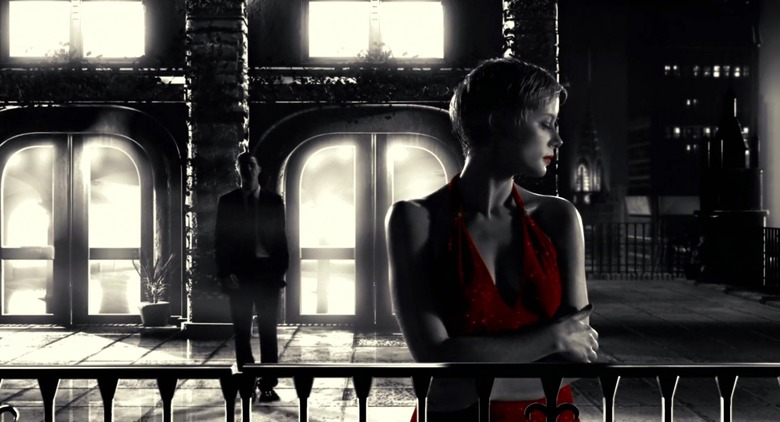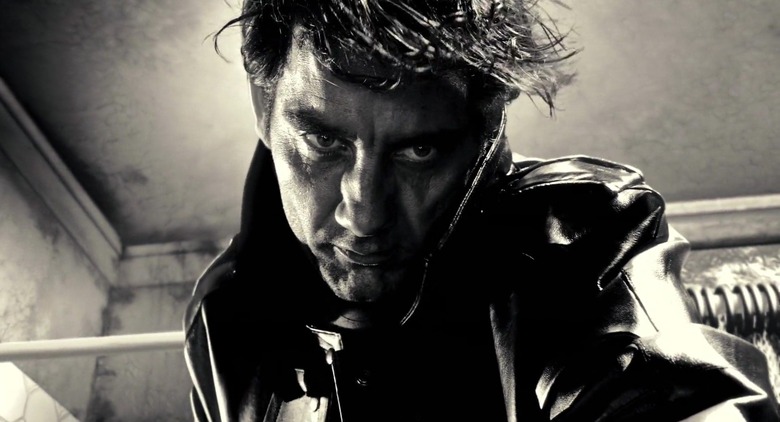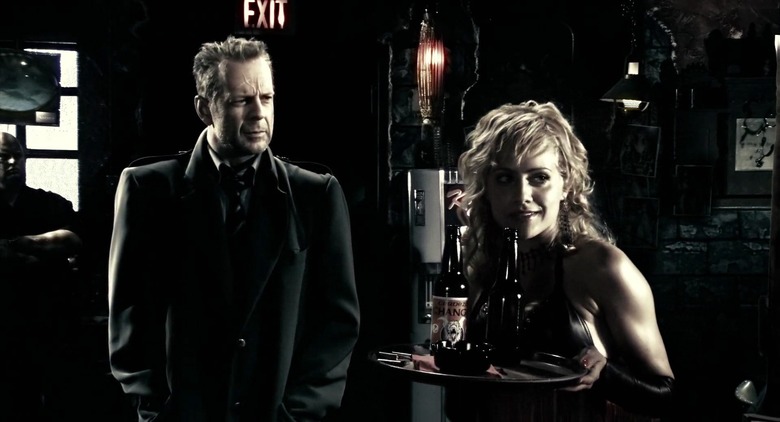15 Years Later, 'Sin City' Remains One Of The Most Faithful And Unique Comics-To-Film Adaptations
Snowpiercer. A History of Violence. Oldboy. Road to Perdition. There are any number of top-notch comic book movies that don't revolve around costumed superheroes. One of the best of these is Frank Miller and Robert Rodriguez's Sin City, a film that pushed the genre forward fifteen years ago with trailblazing black-and-white visuals ripped straight from the comics.
On April 1, 2005, Sin City ushered theatergoers into a world unlike anything they had ever seen before on the big screen. Lurid yet literate, with voiceovers like thought bubbles, the film was something new and remarkable: neo-noir with a heap of violence and the look of a live-action motion comic. With cinemas now closed and most people's travel plans on pause due to the global coronavirus pandemic, it's as good a time as any for pulp-lovers who are stuck at home to take a trip back to Sin City.
The Illustrator Is Always Right
The vast majority of comic book movies have followed a model of loose adaptation, transplanting characters and stories from the print medium without a slavish devotion to the source material. Most of the ones you saw coming out of Hollywood in the first half of the 2000s were so loosely adapted as to be unrecognizable. Heroes like Daredevil, who Miller helped define in "Born Again," The Man Without Fear, and other tales, were marooned in wishy-washy flicks where they and their classic villains only bore a passing resemblance to their comic book counterparts.
Into this climate, came Robert Rodriguez, who had already built his reputation as a maverick "one-man film crew:" writing, producing, directing, as well as serving as cinematographer, production designer, camera operator, editor, composer, and VFX supervisor on many of his own films. With all these titles registered to his name, you might think Rodriguez would want to plant more me-flags all over the credits of Sin City. However, he is also a filmmaker who has shown himself to be rather atypical when it comes to sharing credit.
Some of his most entertaining movies, in fact, have come when the one-man film crew was paired with other innovative storytellers, who could supplement his technical prowess with a dash of their own creative energy. After bursting onto the '90s film scene with El Mariachi and Desperado, Rodriguez soon linked up with such in-demand screenwriters as Quentin Tarantino and Kevin Williamson to collaborate on guilty pleasures like From Dusk Till Dawn and The Faculty. More recently, Rodriguez teamed with uber-producer and screenwriter James Cameron for the cyberpunk manga adaptation, Alita: Battle Angel.
For Sin City, Rodriguez quit the Director's Guild of America so that Frank Miller could receive a co-director credit with him. He also let his old pal Tarantino guest-direct a scene. After shooting and showing Miller the opening sequence, "The Customer Is Always Right," as proof of concept, he convinced the legendary comics creator to make the film.
It's easy to see how three minutes of test footage, the film's eventual intro, could persuade actors like Bruce Willis to join the cast of Sin City, along with Miller. "The Customer Is Always Right" is instantly evocative, layered with police sirens, moody saxophone and piano cues, and a purple-prose voiceover that grows riper by the second with similes and metaphors.
"The wind rises electric," narrates the Salesman (Josh Hartnett), as he pulls himself closer to the Customer (Marley Shelton), a woman in a red dress on a penthouse balcony. She's a grown-up version of the girl in red from Schindler's List, only the film she's in is sleazier and more stylized. Throughout the movie, select colors infiltrate the black-and-white world of Basin City. It's a rainy night there and the Customer's eyes flare green as the Salesman lights her cigarette. Their white silhouettes embrace against a black background; and he knows she's running from something, this beautiful stranger, so he comforts her. Then, the twist comes and the film reveals its true bleak nature.
"The silencer makes a whisper of the gunshot." The Salesman is a hitman, it turns out, and the Customer is his target. Amid the interplay of light and shadow — which recalls film-noir history as much as Miller's rich comic book art — a streak of nihilism runs through Sin City. As the Customer slumps in the Salesman's arms, the film shatters its faux poetry with the hard-boiled line, "I'll cash her check in the morning." That tells you everything you need to know about the movie you are about to watch. And away we go.
Rodriguez approached Sin City as a direct "translation" of Miller's Eisner Award-winning comic series, published by Dark Horse and collected in seven trade paperback editions. It was a novel approach for a comic book movie, one that hewed to the idea that the illustrator was always right. Rather than mess with success, Rodriguez deferred to Miller's drawings, letting them provide the storyboards for the film, with images like Hartigan stepping out of the penitentiary gate into the snow leaping off the page onto the screen.
Knights in Rusty Armor
Though not officially demarcated with chapters, the resulting anthology film, Sin City, drew primarily from three volumes: The Hard Goodbye, The Big Fat Kill, and That Yellow Bastard. The first of these was instrumental in reviving the career of Mickey Rourke. Sin City thrust the mercurial '80s star back into the limelight. After this movie, he would segue into other high-profile projects like The Wrestler and Iron Man 2.
An impressive flattop and prosthetic brow, nose, and chin disguise Rourke's facial features as he disappears into the role of Marv—a walking brick pile in a trench coat, capable of kinetic physical feats that could only happen in the hyper-reality of Sin City. Marv's mug looks like a cross between Boris Karloff's Frankenstein monster and some angular, monochrome cast-off from Dick Tracy's seven-color rogues gallery. Doors explode open when he hits them and he can rip barred windows out of the wall with his bare hands. As he investigates and avenges the death of his fabled one-night stand, Goldie (Jamie King), cars knock him around like a bowling pin and he gets slashed up, shot, beaten, and shot some more. Yet he keeps going—all the way to the electric chair.
That's the thing about Sin City. It's a place where heart-shaped beds and deep prison cages are surrounded by utter darkness. Only brute actions on the part of doomed men seem to penetrate the void. As their fatalistic urges edge them closer to annihilation, these men cling to gallant notions of self-sacrifice. They talk about saving the lives of little girls as if they deserve to be punished for their outmoded chivalry. While he is being tortured by a fellow cop, Willis's character, Hartigan — who carries a cross-shaped forehead scar — muses, "This is nothing but a price I promised myself I'd pay."
Hartigan, like Marv, is an almost superhuman meat grinder when it comes to weathering violence ... and dispensing it. In warehouses, his bullets send twins flying. On docks, he shoots off ears, hands, and private parts. In barns, he bashes faces into squishy yellow puddles. All of it comes as necessary so that he can rescue a damsel in distress: the true-hearted, angelic ecdysiast, Nancy. Raise your hand if you rushed out after the movie, back in 2005, and started buying up the books whose bindings formed a prurient picture of Nancy.
The film itself and its three male protagonists — who collectively harken back to the trifold perspective of L.A. Confidential — are clearly conscious of their own stunted savior complex, or white knight syndrome. That's the vision of masculinity that Miller wants to present as part of this seedy city. As it follows Hartigan, Marv, and its other knight in rusty armor, Dwight, played by Clive Owen, Sin City chucks out names from Arthurian legend like Lancelot and Galahad. In one of his deadpan voiceovers, Dwight likens Marv to a Roman gladiator. He says they would have "tossed him girls" had he not been "born in the wrong century."
Between Sin City and Children of Men, 2005–2006 was peak Clive Owen. Yet Owen, Rourke, Willis, and the other aforementioned performers were really just the tip of the iceberg, as far as acting talent goes. Sin City was stacked with a stellar ensemble cast, including Brittany Murphy, Michael Clarke Duncan, Powers Boothe, and Rutger Hauer (all four of whom have since passed away), as well as Devon Aoki, Alexis Bledel, Rosario Dawson, Benicio del Toro, Carla Gugino, Michael Madsen, and Elijah Wood.
Some of these actors were at the height of their careers; others were at a crossroads. Wood, for instance, had just finished up The Lord of the Rings two years prior, and his mute turn as the clawed, cannibal choir boy, Kevin, would seem him venturing down a darker indie path that has continued to this day with thrillers like I Don't Feel at Home in This World Anymore and Come to Daddy.
In amongst all the other familiar faces, you can even spot Nick Offerman with bleached blonde hair and a nose ring. He plays Burt Schlubb, one of two goons with "delusions of eloquence" that Hartigan encounters. In contrast to Sclubb and his associate Klump's wordiness, note how terse and telegraphic Hartigan's voiceover is when we are first introduced to him in the car. This is another hallmark of some noir writing, like the novels of James Ellroy. Information arrives in punchy little sentence fragments:
"Just one hour to go. My last day on the job. Early retirement. Not my idea. Doctor's orders. Heart condition. Angina, he calls it."
The Hard Movie Goodbye
Then there are the women of Sin City, Goldie and Lucille and Shellie and Gail and the others. If the men in Miller's world are knights and gladiators, the women are goddesses and Valkyries: hookers with hearts (and hair) of gold, lesbian parole officers, coquettish, pouty-lipped waitresses, dominatrixes in stilettos with uzis, and cowgirl strippers who don't actually strip because they're Jessica Alba. It would be all too easy to label Sin City misogynistic. The evidence is there in these sexualized depictions and in the way the film's trenchcoat warriors backhand any dizzy dames or broads who might impede them from playing hero. However, the shriveled black heart beating at the center of this film is more self-loathing in nature.
Marv and Hartigan are too worshipful of their own unattainable ideal of women to be lumped together with the fiends who bullwhip pretty girls and mount their heads on the wall as trophies. What they're up against is the system: a corrupt network of dirty cops, vituperative priests, cannibalistic cardinals, rough mob valets, lying senators, their sadistic sons, and the bald yellow freaks that those sons become after they've had parts of their bodies regrown.
In the all-powerful Roark dynasty, the nastiest piece of work is Junior (Nick Stahl, fresh off Terminator 3 and Carnivale at the time). Junior bleeds white, then yellow. At the farm, which might as well be a castle, he prances around in his boxers, wielding a knife with his distended belly exposed, as if to show how able-bodied a persecutor of maidens he can be. The film almost defies criticism by wringing out the dishrag of cliches into a new murky glass of genre juice.
That's Sin City. It's a movie where more than one head gets dipped in an unflushed toilet. If that sounds insufferable, this may not be the movie for you. All others are advised to revisit the streets of Old Town, where deadly little Miho prowls rooftops, and blue-eyed prostitutes, decked in cross earrings and necklaces, stroll parallel to cruising cars.
Rodriguez, John Debney, and Graeme Revell's soundtrack slinks along with them like a cat burglar. The green-screened, soundstage look of Sin City, the fight scenes between actors who never met on set, help give it an artificial feel that is appropriate to the milieu of a comic book come to life. As much as they might drip atmosphere, one thing the comics can't do, however, is pulse with music and sound the way the movie does.
The quality of Miller's graphic novels fell off toward the end and the quality of the Sin City films followed suit, with the sequel to this one, A Dame to Kill for, arriving nine years later and failing to recapture the same magic. Nothing can diminish or detract from what Rodriguez, Miller, and their cast and crew achieved the first time around, however. A decade and a half later, Sin City still commands respect as one of the most vividly realized non-superhero comic book adaptations ever put to the big screen.
There's been talk of a TV series and we'll see where that goes. In the right writers' room, it certainly feels like there are more stories you could tell in Basin City. Then again, maybe Hollywood just needs to leave this one be and say a hard movie goodbye to Sin City. For now, at least, the original film and the graphic novels remain the best source for anyone looking to re-experience the city's visceral thrills. "Walk down the right back alley in Sin City and you can find anything."



